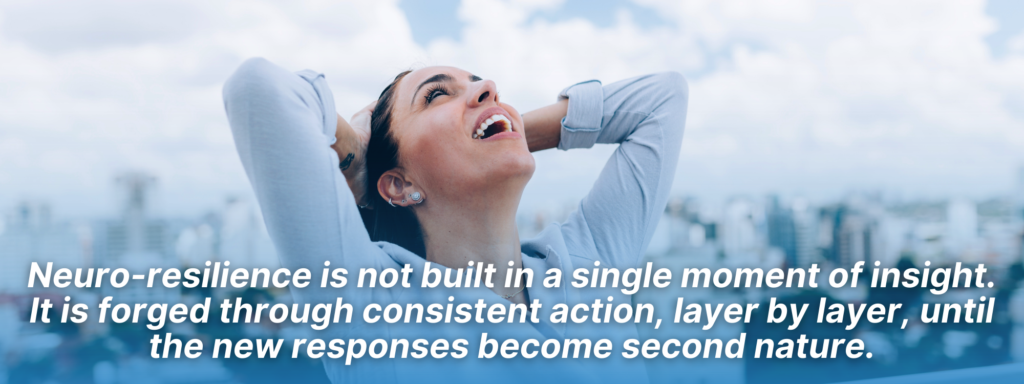Stress has a way of embedding itself into daily life with all the subtlety of a creeping vine, unnoticed until it has coiled around every moment. You wake to the glow of a phone screen, the first notification nudging you into vigilance before your feet even touch the floor. The coffee is too bitter, the train too crowded, the inbox too full, and by the time the day has truly begun, your nerves have already been primed, each irritation an ember waiting for the next spark.
This is not the dramatic, fight-or-flight stress of life-or-death moments; this is the slow, quiet kind that seeps into the background, reshaping perception itself. When stress becomes habitual, responses become reflexive. A sharp email triggers defensiveness, a minor inconvenience draws an exaggerated sigh, a well-meaning question is met with clipped irritation. And yet, this shift often goes unnoticed until a breaking point—an outburst, an uncharacteristic reaction, a moment that makes you realise that the problem is no longer just what happens to you, but what has been happening within you all along.
It is tempting to believe that if only life were a little calmer, the tension would dissipate. But external peace does not guarantee internal calm. Stress is not merely an environmental condition; it is a pattern. And like any pattern, it can be rewritten. The work of resilience is not about waiting for life to become easier—it is about learning to navigate it with greater skill.

Reclaiming Control
Imagine a ship at sea, gliding smoothly under clear skies. Then, without warning, the wind shifts. Dark clouds gather, waves rise, and the once-placid water churns. In that moment, the sailor has a choice: curse the storm, panic, or adjust the sails and navigate through.
Stress operates in much the same way. Many react by resisting—pushing harder, clenching through frustration, hoping that sheer force will quell the discomfort. Others retreat, overwhelmed, hoping that if they ignore the rising tension, it will pass. But neither approach leads to mastery. Resilience lies in a third path: understanding stress well enough to work with it, rather than against it.
The body’s stress response is an evolutionary marvel—an ancient mechanism designed for survival. It sharpens attention, heightens reaction speed, and prepares the body for action. But in the modern world, the same chemical cascade is triggered by unanswered emails and looming deadlines, with nowhere for the energy to go. Without an outlet, stress compounds, accumulating in the body as tension and in the mind as constant unease. The challenge is not in eliminating stress, but in learning how to step out of it when it is no longer useful. A sailor does not demand the wind change course; they adjust their approach. Likewise, resilience is the ability to regulate rather than resist, to return to calm before stress becomes toxic.
This shift is not purely mental. The body must be engaged. A clenched jaw, tense shoulders, a shallow breath—these are not just symptoms of stress; they are amplifiers. Reverse them—soften the jaw, lower the shoulders, slow the breath—and the stress response begins to unwind. A single deep breath, held for a moment and exhaled slowly, can do more to restore balance than an hour of anxious overthinking.

Reframing the Narrative
Imagine a well-trodden path through a dense forest. Each step follows the same worn track—predictable, familiar, but leading nowhere new. Now imagine stepping off that path, forging a new trail. At first, it is uncertain, each movement a conscious effort. But with time and repetition, the new route becomes easier, clearer, the old path fading into irrelevance. This is the essence of neuro-resilience—not eliminating stress, but reshaping the way we respond to it.
One of the most powerful tools in this process is reframing. Stress is often perceived as something external, something done to us. But stress is not the event itself—it is the meaning we assign to it. A demanding boss, a delayed train, a difficult conversation—none of these inherently create stress. What does is the interpretation: I am failing, I am disrespected, I cannot handle this. These interpretations are reflexive, shaped by past experiences and habitual thinking. But they are not fixed.
Consider the Stoic approach: the world does not happen to us; we happen to the world. The rain does not ruin the picnic; the picnic simply takes place in the rain. The high-pressure meeting is not a trial; it is a test of skill. Reframing does not mean ignoring difficulty—it means choosing a perspective that is useful. The moment we shift from Why is this happening to me? to How can I use this?, we reclaim control.
But perspective alone is not enough. The nervous system must be trained alongside the mind. A professional athlete does not calm their thoughts first and their body second; they regulate their breathing, their stance, their movement—because state control is physiological before it is psychological. The same is true in everyday resilience. By training the body to shift out of stress, we train the mind to do the same.
And just as a path in the forest deepens with each step, these practices—reframing, physical regulation—become stronger with repetition. Neuro-resilience is not built in a single moment of insight. It is forged through consistent action, layer by layer, until the new responses become second nature. Stress may still arise, but it no longer dictates the journey. A new route has been carved—one that leads not just to survival, but to strength.

Stress to Strength
If stress were an enemy, the solution would be simple: eliminate it. But stress is not an adversary; it is energy—raw, untamed, and neutral—waiting to be directed. The question is not How do I get rid of stress? but How do I use it?
Think of a blacksmith before a roaring furnace. The fire burns, metal glows red-hot, and with each strike of the hammer, a blade takes shape. Without the fire, the metal remains inert. But unchecked, the same fire can warp and crack the material. Stress functions in precisely the same way. Too much, and we break. Too little, and we stagnate. Mastery lies in tempering rather than avoiding it.
A resilient leader understands this. They do not merely endure stress; they transform it. Pressure, when harnessed, sharpens focus and strengthens resolve. But they also recognise that unregulated stress corrodes, that allowing it to accumulate unchecked leads to exhaustion and poor decisions.
The key is intelligent recovery. Just as an athlete does not train at full intensity every day, resilience is built through cycles of effort and restoration. A leader who takes moments to reset—through deliberate breathing, movement, or even strategic disengagement—will outlast the one who grinds forward relentlessly.
And the final measure of resilience is not individual endurance, but influence. A leader does not simply regulate their own stress—they set the emotional climate for those they lead. Walk into a room where the leader is composed, and the group steadies. Walk into a room where they are frazzled, and unease spreads. Resilience, then, is not just personal—it is contagious.
So the question remains: How do I use stress? The answer is transformation. Stress is not something to fear. It is the forge, the fire, the necessary heat that strengthens rather than weakens—if we learn to wield it well. A leader who understands this does not brace for impact. They stand steady at the helm, knowing that every challenge, every moment of intensity, is not an obstacle, but an opportunity to refine, adapt, and emerge stronger.



